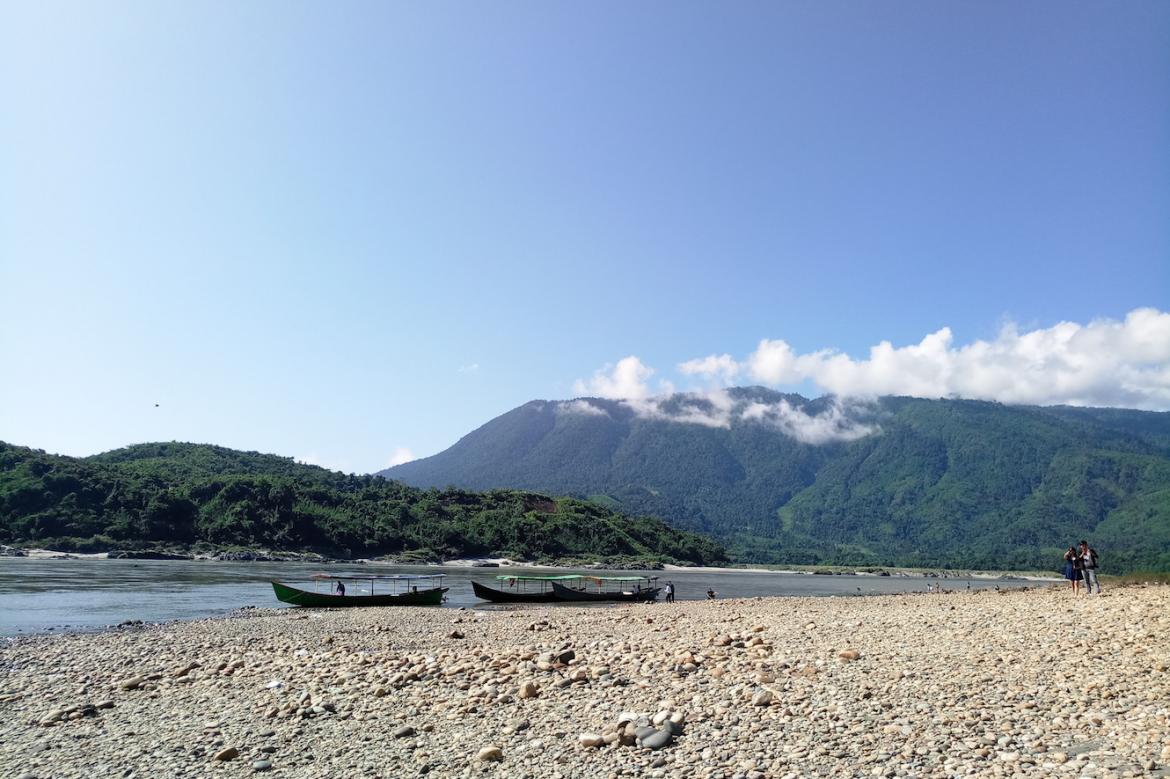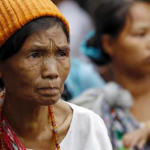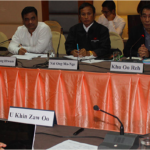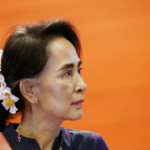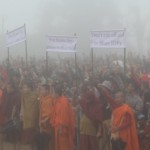Yanghee Lee & Debby Sze Wan Chan/Frontier Myanmar | November 11, 2017
An inclusive and deliberative approach to addressing the Myitsone Dam dispute can showcase the government’s commitment to genuine change as well as the peace process.
LIKE MANY mega projects in Myanmar, the Myitsone Dam has historically excluded the communities that are likely to be most affected.
Lessons from the past must be learnt. The pending decision on the future of the Myitsone Dam – as well as many other projects across the country – offers an opportunity to show that the government is accountable to the public.
A year ago, on November 11, 2016, the commission tasked with reviewing the dam project submitted its report to President U Htin Kyaw. Former President U Thein Sein halted the China-backed project in September 2011 amid popular opposition, but this suspension expired in March 2016 when his government left office.
The establishment of the commission was widely perceived as a strategy to defuse pressure from Beijing before State Counsellor Daw Aung San Suu Kyi’s visit to China.
But the Myitsone Dam controversy is more than a foreign relations issue. It also concerns the new leadership’s commitment to transparency, human rights and the peace process. Against this background, people have high hopes that the democratic government will settle the dispute by following public opinion.
Although the report was submitted a year ago, it has not yet been released to the public. As a result, the majority of the country has been neither included nor informed by the government in its decision-making on a potential settlement.
Before taking office on March 30, 2016, Aung San Suu Kyi had opposed the Myitsone Dam, a project that could inundate the homeland of 18,000 Kachin people and pose environmental threats to the Ayeyarwady River. During the election campaign she also championed transparency of the project.
Nevertheless, the National League for Democracy-led government is in a dilemma because it inherited a signed bilateral agreement. Whether it decides to continue or discontinue the project, it will face legal and political ramifications: cancel and it could face a huge compensation claim; go ahead and it risks disappointing domestic constituents.
While the NLD-led government is in a quandary over the Myitsone Dam case, it is hesitant to share information with the public – perhaps in an attempt to avoid generating further domestic constraints before it arrives at a resolution with other actors involved.
However, the Myitsone Dam dilemma could have been averted if the Myanmar government had complied with the United Nations Guiding Principles on Business and Human Rights (hereafter referred to as guiding principles).
The government’s responsibility under the guiding principles is two-fold. First, it bears primary responsibility to prevent and protect against human rights violations in relation to business activities as well as provide remedies for the victims. It must enact and implement laws and policies to address the risk of human rights violations stemmed from business activities, especially in the conflict areas.
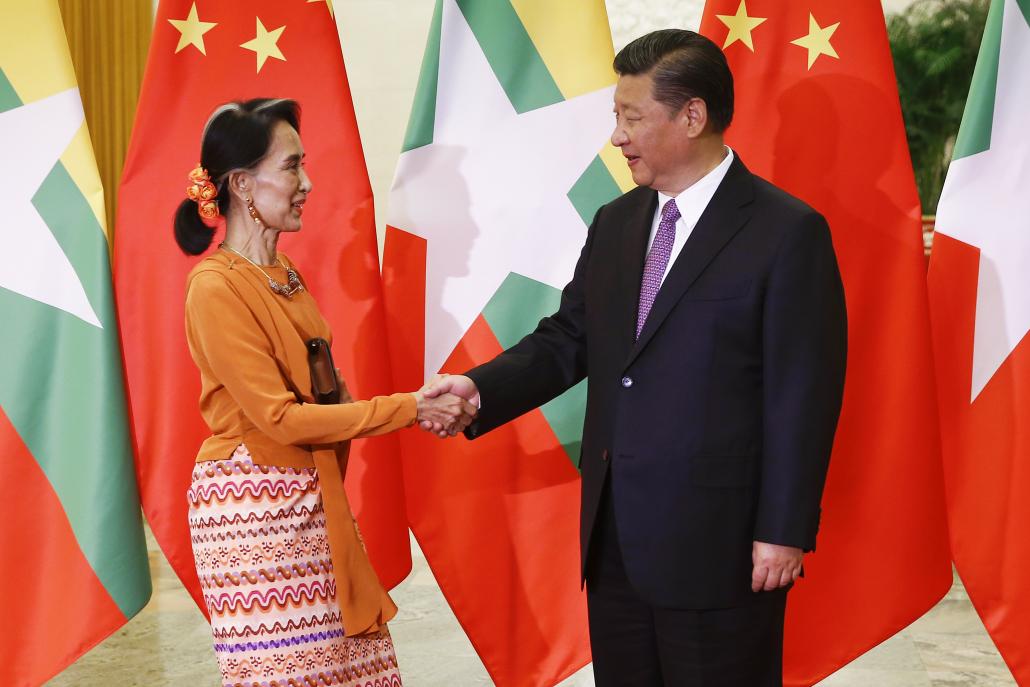
State Counsellor Daw Aung San Suu Kyi shakes hands with Chinese President Xi Jinping during a meeting at the Great Hall of the People in Beijing on May 16. (AFP)
Yet, the environmental impact assessment (EIA) was not in place when the government signed the contract. Villagers were forcedly evicted from their ancestral land to make way for the project. The Myitsone Dam has been blamed as one of the factors in the collapse in June 2011 of the ceasefire agreement between the Myanmar government and the Kachin Independence Organization.
Second, the Myitsone Dam project is a joint venture between the Myanmar government and state-owned China Power Investment. As an investor, the government – along with its business partners – should uphold transparency and communicate with affected stakeholders of the mega project in line with principles 20 and 21 of the guiding principles. In 2014, over 1,000 Kachin villagers displaced by the Myitsone Dam launched a civil referendum. They categorically communicated their disapproval of the project. The outcome of the civil referendum reflected the fact that both the government and the Chinese company have failed to convince local stakeholders that they could benefit from the project.
The Myitsone Dam is not an exceptional case; Myanmar has many other large projects that are unpopular with the public. The Thanlwin River dams, the Thilawa Special Economic Zone, the Letpadaung copper mine, the Kyaukphyu SEZ and the Dawei oil refinery have all faced different levels of social resistance owing to the negative impacts on the rights of communities. It is disappointing that, in the past, local people’s opinion was not considered seriously before the government inked agreement with foreign investors. Even worse, on many occasions protesters have been repressed by the authorities for expressing their disapproval. The use of phosphorous bombs against protesters and the killing of a female villager in relation to the Letpadaung copper mine controversy were among the most severe human rights violations inflicted in the name of economic development. Until now, there has been no justice for the victims.
The lessons from these mistakes must be learnt. The rationale of the developmental projects should be to improve the living standards of the general public. Put simply, soliciting local people’s support is not an instrumental means to proceed with the project but an intrinsic step to make the government accountable to the citizens.
During country visits, communities in several areas have told the special rapporteur that they understood the need for Myanmar to develop. Yet, they doubt whether their suffering could bring benefits for their community or even the country as a whole. Some referred to the Myitsone Dam case – and specifically reports that 90 percent of the electricity generated would be exported to China – as illustrating a disproportionate distribution of gains of the joint project. Others cite the China-Myanmar oil pipeline, a project where civil society organisations also claimed that the profit sharing agreement signed by the military government disadvantaged Myanmar. For the same reason, the Thein Sein administration and the Htin Kyaw administration attempted to renegotiate the terms of the agreement with China.
In the post-military era, Nay Pyi Taw put in place laws and regulations in order to address the potential adverse impacts of the mega projects. These include the Environmental Conservation Law (2012), the Environmental Conservation Rules (2013) and the Environmental Impact Assessment Procedures (2016). However, they needed to be implemented in letter and spirit rather than just as another tick-box activity. Social impact assessments, as part of the EIA, must be carried out prior to the implementation of any developmental projects, and local stakeholders should be genuinely consulted and involved in the process.
Although consultations with affected communities are mandatory under the Environmental Impact Assessment Procedures, there are many cases indicating huge gaps between legal standards and business practices on the ground. For example, non-governmental organisations have reported that local people’s land was confiscated prior to the completion of the EIA for the Kyaukphyu SEZ.
More problematically, many of the mega projects, including the Myitsone Dam, the Thanlwin dams, the China-Myanmar oil and gas pipelines, and the Kyaukphyu SEZ, are situated in ethnic minority-dominated states. Local stakeholders worry that even the state governments have little control over the projects because the international agreements were concluded between Nay Pyi Taw and foreign investors.
The grievances of the affected communities must not be overlooked. Mega projects in the ethnic states that tap natural resources, destroy the environment and confiscate land in ethnic minority states may undermine the government’s endeavours to promote national unity. Given that trust is critical in moving the peace process forward, insisting on the implementation of unfavourable mega projects on ethnic nationals’ soil may in fact hinder the peace process.
The NLD-led government offered a welcome promise of change to the people. After decades of dictatorship, the new leadership has inherited tremendous challenges from previous governments. While recognising the constraints, the litmus test of the actualisation of change is whether Nay Pyi Taw will learn lessons and stand up for the rights of affected communities.
The majority in central Myanmar remain hopeful that the NLD can deliver both economic development and respect for human rights. An inclusive and people-oriented approach to development projects can demonstrate the change that the democratic government promised the people of Myanmar, including ethnic minorities.
Increasing transparency and inclusivity in the Myitsone Dam controversy, as well as in other pending and new projects, will create invaluable opportunities for the NLD-led government to build trust. At the same time, unilateral decisions by the government risk pushing ethnic minority people in another direction.
This article originally appeared on Frontier Myanmar on November 11, 2017

